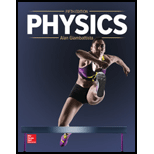
Concept explainers
(a)
Identify the unknown product in the reaction of
(a)
Answer to Problem 87P
The unknown product in the reaction of
Explanation of Solution
The given reaction iss
Here,
Conservation of nucleon number: The number of nucleon number in reactant is equal to the number of nucleon number in the product of the reaction. Therefore,
Conservation of charge: The number of protons in reactant is equal to the number of protons in the product of the reaction. Therefore,
In periodic table, the element with atomic number
(b)
The distance between the centers of alpha particle and nitrogen nucleus when they are just touching.
(b)
Answer to Problem 87P
The distance between the centers of alpha particle and nitrogen nucleus when they are just touching is
Explanation of Solution
The mass of number of
Write the equation for radius
Here,
The radius of
The radius of
Therefore, the distance between the centers of alpha particle and nitrogen nucleus when they are just touching is
(c)
The minimum value of the kinetic energy of the alpha particle and nitrogen nucleus necessary to bring them into contact.
(c)
Answer to Problem 87P
The minimum value of the kinetic energy of the alpha particle and nitrogen nucleus necessary to bring them into contact is
Explanation of Solution
The distance between the centers of proton and nitrogen nucleus when they just touching is
Write the formula for electric potential energy
Here,
Substitute
Therefore, the minimum value of the kinetic energy of the alpha particle and nitrogen nucleus necessary to bring them into contact is
(d)
Whether the total kinetic energy of the reaction products more or less than the kinetic energy in part (c). And calculate the kinetic energy difference.
(d)
Answer to Problem 87P
The total kinetic energy of the reaction products is less than the initial kinetic energy of the reactants. And the difference in their kinetic energy is
Explanation of Solution
The
Write the formula for energy
Here,
The mass difference between the product and the reactant of the overall equation is
The mass difference is positive, the mass of the product is greater than the mass of the reactant. Therefore the kinetic energy of the product is less than the kinetic energy of the reactant.
Substitute
Thus, the difference in their kinetic energy is
Want to see more full solutions like this?
Chapter 29 Solutions
Physics
- Consider a uniformly charged ring of radius R with total charge Q, centered at the origin inthe xy-plane. Find the electric field (as a vector) at a point on the z-axis at a distance z above thecenter of the ring. Assume the charge density is constant along the ring.arrow_forward3) If the slider block C is moving at 3m/s, determine the angular velocity of BC and the crank AB at the instant shown. (Use equation Vs Vc wx fuc, then use equation Vs VA + Ve/athen write it in terms of w and the appropriate r equate the two and solve) 0.5 m B 1 m 60° A 45° vc = 3 m/sarrow_forward3) If the slider block C is moving at 3m/s, determine the angular velocity of BC and the crank AB at the instant shown. (Use equation Vs Vc wxf, then use equation V, VA + Va/Athen write it in terms of w and the appropriate r equate the two and solve) f-3marrow_forward
- Pls help ASAParrow_forwardPls help ASAParrow_forward14. A boy is out walking his dog. From his house, he walks 30 m North, then 23 m East, then 120 cm South, then 95 m West, and finally 10 m East. Draw a diagram showing the path that the boy walked, his total displacement, and then determine the magnitude and direction of his total displacement.arrow_forward
- Pls help ASAParrow_forward12. A motorboat traveling 6 m/s, West encounters a water current travelling 3.5 m/s, South. a) Draw a vector diagram showing the resultant velocity, then determine the resultant velocity of the motorboat. b) If the width of the river is 112 m wide, then how much time does it take for the boat to travel shore to shore? c) What distance downstream does the boat reach the opposite shore?arrow_forwardLake Erie contains roughly 4.00⋅10114.00⋅1011 m3 of water. Assume the density of this water is 1000. kg/m3 and the specific heat of water is 4186 J/kg˚C. It takes 2.31x10^19 J of energy to raise the temperature of that volume of water from 12.0 °C to 25.8 ˚C. An electric power plant can produce about 1110 MW. How many years would it take to supply this amount of energy by using the 1110 MW from an electric power plant?arrow_forward
 College PhysicsPhysicsISBN:9781305952300Author:Raymond A. Serway, Chris VuillePublisher:Cengage Learning
College PhysicsPhysicsISBN:9781305952300Author:Raymond A. Serway, Chris VuillePublisher:Cengage Learning University Physics (14th Edition)PhysicsISBN:9780133969290Author:Hugh D. Young, Roger A. FreedmanPublisher:PEARSON
University Physics (14th Edition)PhysicsISBN:9780133969290Author:Hugh D. Young, Roger A. FreedmanPublisher:PEARSON Introduction To Quantum MechanicsPhysicsISBN:9781107189638Author:Griffiths, David J., Schroeter, Darrell F.Publisher:Cambridge University Press
Introduction To Quantum MechanicsPhysicsISBN:9781107189638Author:Griffiths, David J., Schroeter, Darrell F.Publisher:Cambridge University Press Physics for Scientists and EngineersPhysicsISBN:9781337553278Author:Raymond A. Serway, John W. JewettPublisher:Cengage Learning
Physics for Scientists and EngineersPhysicsISBN:9781337553278Author:Raymond A. Serway, John W. JewettPublisher:Cengage Learning Lecture- Tutorials for Introductory AstronomyPhysicsISBN:9780321820464Author:Edward E. Prather, Tim P. Slater, Jeff P. Adams, Gina BrissendenPublisher:Addison-Wesley
Lecture- Tutorials for Introductory AstronomyPhysicsISBN:9780321820464Author:Edward E. Prather, Tim P. Slater, Jeff P. Adams, Gina BrissendenPublisher:Addison-Wesley College Physics: A Strategic Approach (4th Editio...PhysicsISBN:9780134609034Author:Randall D. Knight (Professor Emeritus), Brian Jones, Stuart FieldPublisher:PEARSON
College Physics: A Strategic Approach (4th Editio...PhysicsISBN:9780134609034Author:Randall D. Knight (Professor Emeritus), Brian Jones, Stuart FieldPublisher:PEARSON





